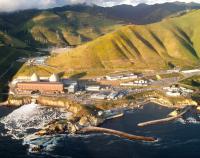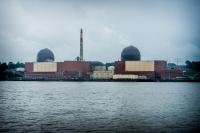-
Cyber Guard 2016 aims to manage complexity in invisible domain
Between one million and ten million U.S. homes and businesses are without power. An oil spill from a near-shore refinery is gushing into the waters off Texas and Louisiana. The port of Los Angeles is shut down due to a network outage. Visitors to exercise Cyber Guard 2016 here viewed mock newscasts detailing these scenarios as examples of the likely effects of a massive cyberattack.
-
-
Diablo Canyon nuclear plant to be shut down, replaced by renewables, efficiency, storage

An historic agreement has been reached between Pacific Gas and Electric, Friends of the Earth (FOE), and other environmental and labor organizations to replace the Diablo Canyon nuclear reactors with greenhouse-gas-free renewable energy, efficiency, and energy storage resources. FOE says the agreement provides a blueprint for fighting climate change by replacing nuclear and fossil fuel energy with safe, clean, cost-competitive renewable energy.
-
-
U.S. court asked to block restart of aging, damaged Indian Point nuclear reactor

Friends of the Earth and other environmental organizations have filed an emergency petition with the United States Court of Appeals for the District of Columbia Circuit asking that the court compel the Nuclear Regulatory Commission to prevent Entergy from restarting an aging Indian Point nuclear reactor which was found to have unprecedented parts failure in its critical core cooling system. Entergy, the owner and operator of Indian Point, has repeatedly stated that it intends to start the reactor within days. The Indian Point reactors’ licenses expired in 2013 and 2015, respectively, and the plant is operating beyond its 40-year life span while the NRC considers whether to extend the license for an additional twenty years.
-
-
The contribution of human dynamics to coastal communities’ resilience
The National Academies of Sciences has established a $10 million grants program to fund projects that enhance the science and practice of coastal community resilience in the Gulf of Mexico region. Rather than focus on infrastructure needs or the built environment, as many existing resilience-focused programs do, the new grants program will support the study of the human dynamics that influence a community’s ability to respond to adverse events.
-
-
Better water management to halve the global food gap
Improved agricultural water management could halve the global food gap by 2050 and buffer some of the harmful climate change effects on crop yields. For the first time, scientists investigated systematically the worldwide potential to produce more food with the same amount of water by optimizing rain use and irrigation. They found the potential has previously been underestimated.
-
-
Pulling water from air
Researchers are tackling the world’s water crisis by pulling water out of the air. Their result is the patent-pending Hybrid Atmospheric Water Generator (HAWgen), which generates clean drinking water from the atmosphere through the integration of sorption, refrigeration and water filtration systems.
-
-
What Flint’s water crisis could mean for the rest of the nation
Elevated levels of lead in the drinking water in Flint, Michigan, brought to light not only the troubles of one city but also broader concerns about the nation’s aging water distribution system. Noted scientist is calling for federal funding to replace deteriorating lead pipes in large swaths of the United States.
-
-
For young engineers, Flint offers a lesson on the importance of listening
Sheldon Masters, a former Virginia Tech Ph.D. student, says he used to think scientists and engineers should be like robots: “Emotionally unattached.” But after attending a class entitled “Engineering Ethics and the Public: Learning to Listen” with dozens of other young engineers at his university, he found his perspective changed. Developed with support from a National Science Foundation (NSF) grant, the course is intended to explore the relationship between engineering, science, and society.
-
-
Can drinking water be delivered without disinfectants like chlorine and still be safe?
When we open the tap, we expect the water to be safe. That is, the water should be free of pathogens that could make us sick and any chemicals that could cause problems later in life. For the most part, potable water systems in the developed world have done a great job providing safe water. However, there are still unfortunate situations that develop, resulting in issues with the safety of drinking water. One of the conclusions of the research we have conducted is that potable water systems should consider moving beyond carrying a disinfectant and focus instead on maintaining and replacing their aging delivery systems and upgrading their water treatment steps. This will have the benefit of limiting exposure to DBP while also continuing to deliver safe water to consumers.
-
-
Water pipes crawl with millions of bacteria
Researchers have discovered that our drinking water is to a large extent purified by millions of “good bacteria” found in water pipes and purification plants. So far, the knowledge about them has been practically non-existent, but this new research is about to change that.
-
-
Rigid water pipes, fit for the future
Water infrastructures – such as pipes, sewers, or water storages – are rigid systems. They are renewed according to certain renovation cycles. This can take up to 70 years for municipal sewage systems and up to 30 years for baths in rental apartments. “That has to be considered when creating concepts for the future of the water infrastructure,” says Dr.-Ing. Thomas Hillenbrand, scientist at the Fraunhofer Institute.
-
-
Contamination in North Dakota linked to fracking spills
Accidental wastewater spills from unconventional oil production in North Dakota have caused widespread water and soil contamination, a new study finds. Researchers found high levels of ammonium, selenium, lead and other toxic contaminants as well as high salts in the brine-laden wastewater, which primarily comes from hydraulically fractured oil wells in the Bakken region of western North Dakota.
-
-
Climate change redistributes global water resources
Rising temperatures worldwide are changing not only weather systems, but - just as importantly - the distribution of water around the globe, according to a new study. This study marked the first time scientists have used specific measurements to demonstrate how water sources are changing, especially in the northeastern United States.
-
-
New material promise to make nuclear fuel recycling cheaper, cleaner
Researchers are investigating a new material that might help in nuclear fuel recycling and waste reduction by capturing certain gases released during reprocessing. Conventional technologies to remove these radioactive gases operate at extremely low, energy-intensive temperatures. By working at ambient temperature, the new material has the potential to save energy, make reprocessing cleaner and less expensive. The reclaimed materials can also be reused commercially.
-
-
In Sweden, replacing nuclear power with wind power does not make sense
The Swedish power supply is largely free of carbon emissions. Indeed, it is mainly based on a combination of hydroelectric and nuclear power combined with power exchange with neighboring Scandinavian countries. A new study, investigating the possibility of replacing nuclear power with wind power, which is by nature intermittent, concludes that a backup system, based on fossil fuel, namely gas, would be required in combination with wind power. In such a scenario, the CO2 emissions would double.
-
More headlines
The long view
Helping Strengthen America’s Critical Infrastructure
Everyday life depends on a robust infrastructure network that provides access to running water, communications technology and electricity, among other basic necessities. The experts who keep our national infrastructure secure and resilient also need a strong network to share their knowledge and train the next generation of professionals capable of solving complex infrastructure challenges.
AI and the Future of the U.S. Electric Grid
Despite its age, the U.S. electric grid remains one of the great workhorses of modern life. Whether it can maintain that performance over the next few years may determine how well the U.S. competes in an AI-driven world.
Using Liquid Air for Grid-Scale Energy Storage
New research finds liquid air energy storage could be the lowest-cost option for ensuring a continuous power supply on a future grid dominated by carbon-free but intermittent sources of electricity.
Enhanced Geothermal Systems: A Promising Source of Round-the-Clock Energy
With its capacity to provide 24/7 power, many are warming up to the prospect of geothermal energy. Scientists are currently working to advance human-made reservoirs in Earth’s deep subsurface to stimulate the activity that exists within natural geothermal systems.
Experts Discuss Geothermal Potential
Geothermal energy harnesses the heat from within Earth—the term comes from the Greek words geo (earth) and therme (heat). It is an energy source that has the potential to power all our energy needs for billions of years.
